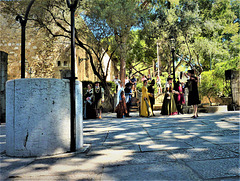J. Gafarot's photos with the keyword: Castelo de S. Jorge
Castelo S. Jorge
| 11 Nov 2019 |
|
|
|
To spend one afternoon re enacting Middle Age plays in the grounds of Castelo de S. Jorge, on top of that hill which dominates the port and all the primitive settlement.
The history of Lisbon, the capital city of Portugal, revolves around its strategic geographical position at the mouth of the Tagus, the longest river in the Iberian Peninsula. Its spacious and sheltered natural harbour made the city historically an important seaport for trade between the Mediterranean Sea and northern Europe. Lisbon has long enjoyed the commercial advantages of its proximity to southern and extreme western Europe, as well as to sub-Saharan Africa and the Americas, and today its waterfront is lined with miles of docks and wharfs. During the Neolithic period, pre-Celtic peoples inhabited the region; remains of their stone monuments still exist today in the periphery of the city. Lisbon is one of the oldest cities in western Europe, with a history that stretches back to its original settlement by the indigenous Iberians, the Celts, and the eventual establishment of Phoenician and Greek trading posts (c. 800–600 BC), followed by successive occupations in the city of various peoples including the Carthaginians, Romans, Suebi, Visigoths, and Moors. Roman armies first entered the Iberian peninsula in 219 BC, and occupied the Lusitanian city of Olissipo (Lisbon) in 205 BC, after winning the Second Punic War against the Carthaginians. With the collapse of the Roman Empire, waves of Germanic tribes invaded the peninsula, and by 500 AD, the Visigothic Kingdom controlled most of Hispania. Part one.
Jump to top
RSS feed- J. Gafarot's latest photos with "Castelo de S. Jorge" - Photos
- ipernity © 2007-2025
- Help & Contact
|
Club news
|
About ipernity
|
History |
ipernity Club & Prices |
Guide of good conduct
Donate | Group guidelines | Privacy policy | Terms of use | Statutes | In memoria -
Facebook
Twitter

